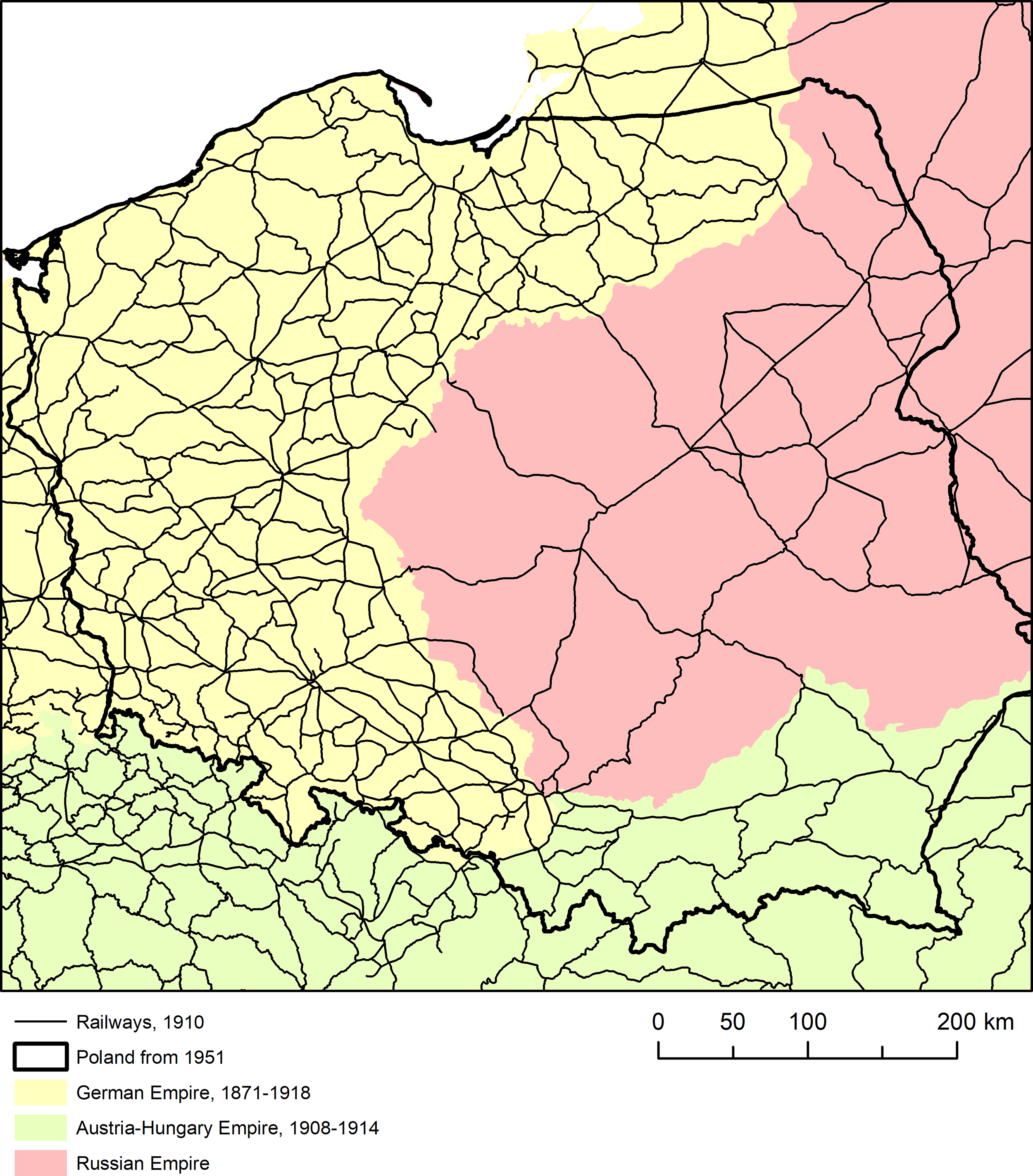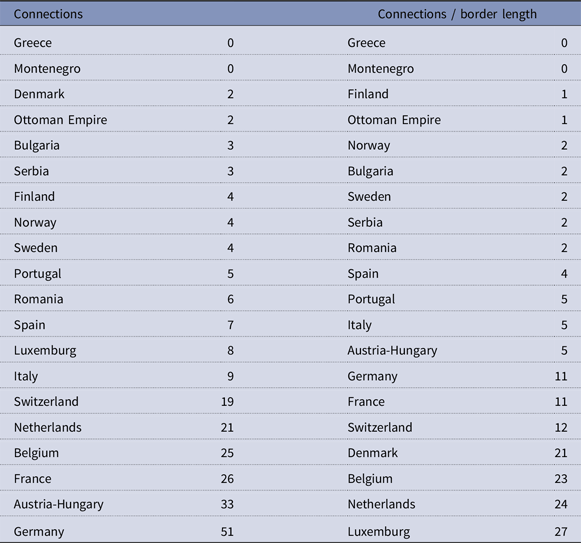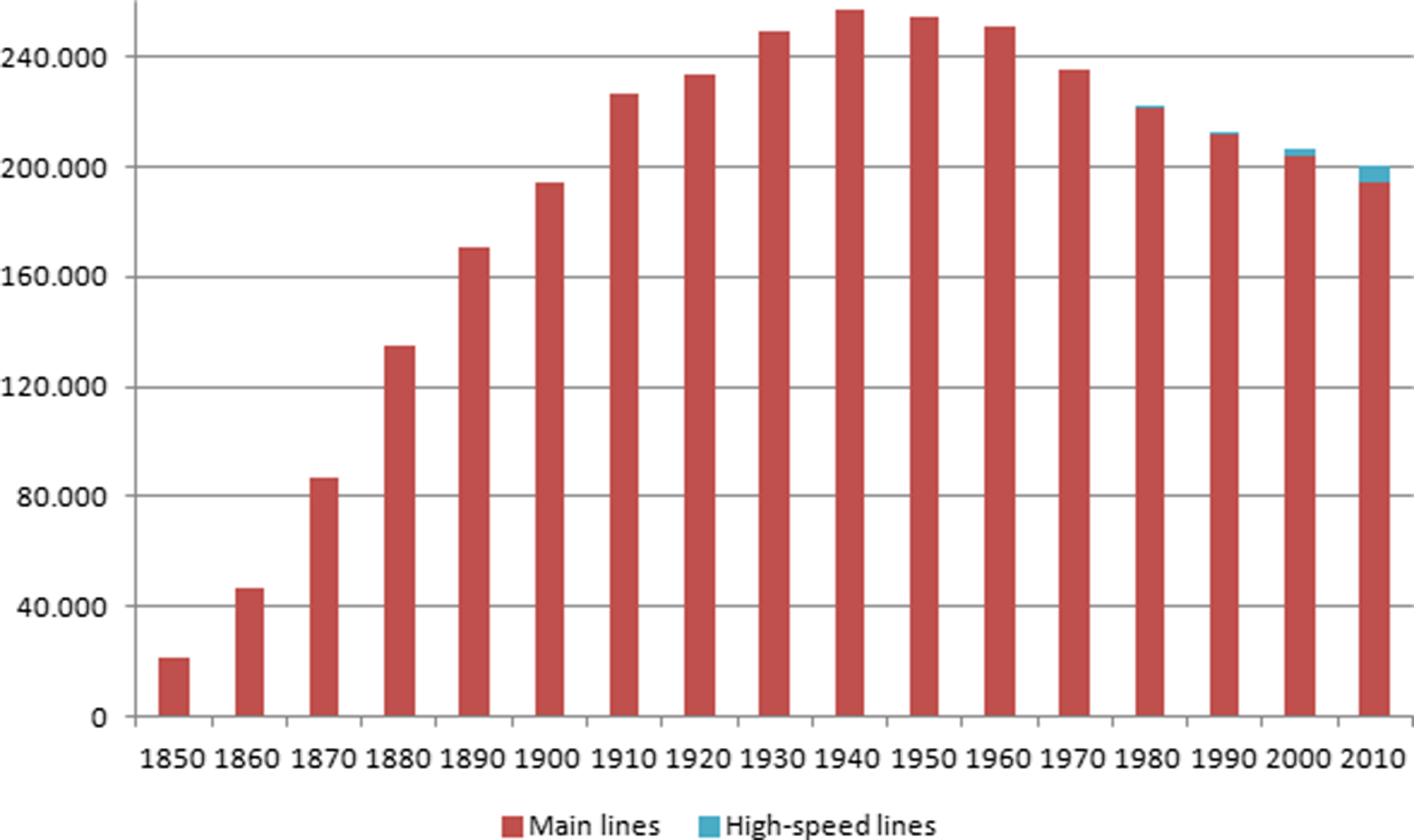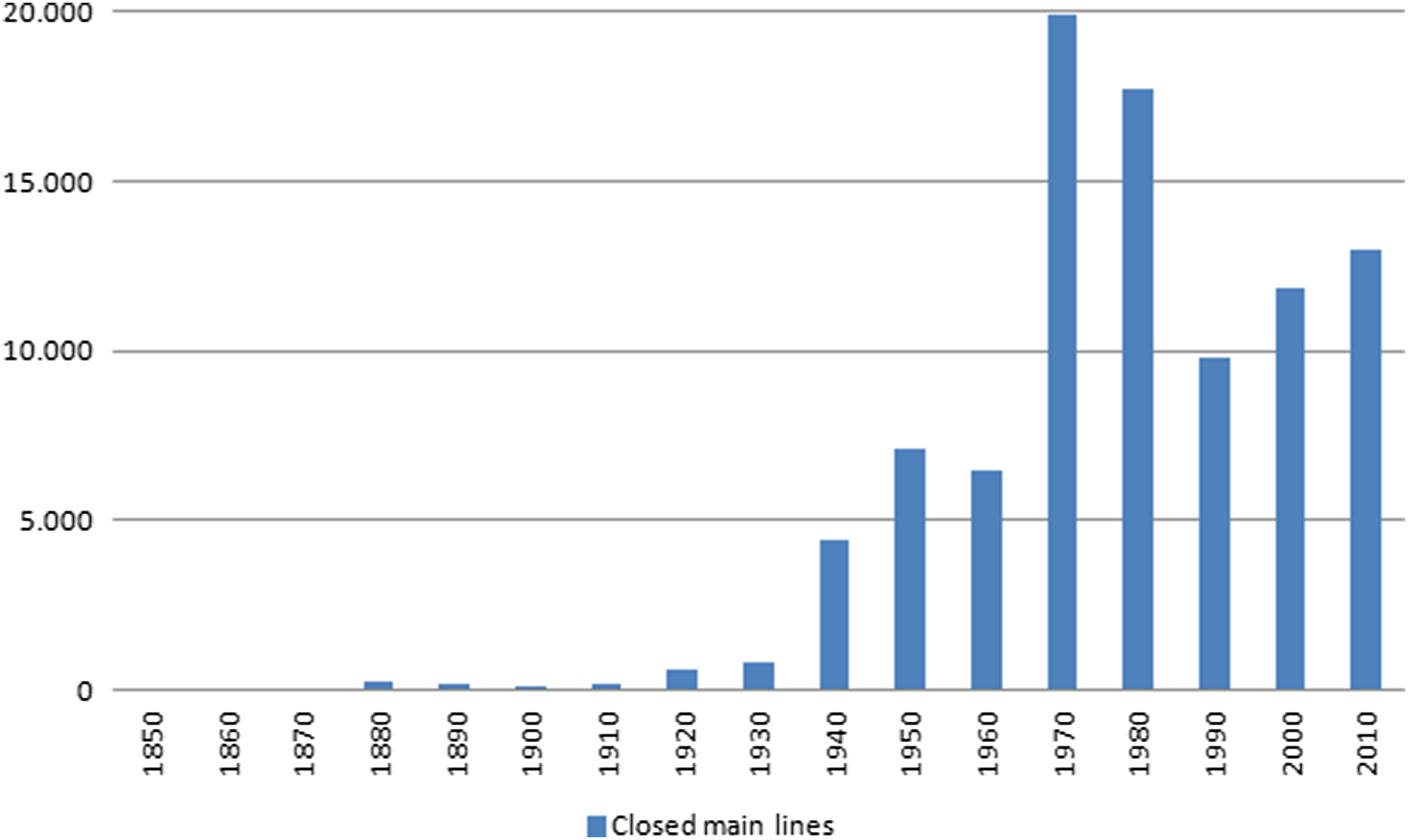This collection of articles combines a set of works that study the contribution of transport infrastructure to the process of state building in different countries in Western and Central Europe. The focus and the themes treated vary, but have two common denominators: firstly, they are based on either completely original, or previously little-used, primary sources; and secondly, each work reveals new ways of interpreting how transport networks have shaped the territories into which they were introduced. Each article is an example of the wealth of potential approaches available and also helps us to interpret the processes involved in state building, which are a necessary precedent to European Integration (EI).
To put the seven works that make up this special issue into context, I shall start this introduction by examining three aspects that complement them. I shall firstly clarify what we mean by EI. Secondly, I shall examine whether EI processes existed prior to the creation of the institutions that were set up after World War II to promote integration. Then, thirdly, and finally, based on the previous analyses, I shall look at the emergence of a railway network in Europe and the role that the European states played in this process. The fourth section will present the articles.
What We Understand by “State Building” and “European Integration” in Terms of Territory
We believe that the processes of state building that took place in Europe during the nineteenth and twentieth centuries heralded the later process of EI.
In reference to EI, Stinsky (Reference Stinsky, Broad and Suvi2020) provocatively titled a recent work: “Integration, Nobody Knows What It Means.” His objective was to point out that many different theories and approaches exist as to how EI can be conceived and therefore promoted. These theories basically differ with regard to the degree of sovereignty ceded by each state within the new supranational entity. According to the federal option, cessions by states should be considerable and favor the creation of a new supranational institution. A model that follows this logic would be the United States. There has, however, been reluctance to do this that has prevented the political classes and societies of the majority of European states from following this route. The main reason for this has been the associated loss of decision-making instruments by the states with respect to domestic economic and social policy. However, as far as our study is concerned, there has always been general support for improving transport and thereby facilitating movement between countries. This was a key factor for promoting a common market, which was the first and founding objective of the European Community (EC). However, as occurs in road cycling for teams, Europe can only advance in fundamental areas at the rhythm imposed by the slowest cyclists. Due to the need for consensus, progress toward EI has not been very quick. That said, the capacity for dialogue between previously antagonistic states, which is the second fundamental objective of the EC, has seen enormous advances.
The EI process has therefore not been unfurled as part of a project of maximums, or as a federal state, but rather in a possibilist way. This has made it possible to maintain a balance between conserving the sovereignty of states and, at the same time, allowing the growth of European institutions and legislation. The result has been to consolidate a free space for the circulation of goods, people, and capital. One of the most fundamental instruments for achieving this has been the ability to promote infrastructure and liberalize transport services. This has facilitated access to the whole territory and allowed movement within a common space.
In summary, we understand EI as the measures adopted by a group of sovereign states to complement and coordinate policies related to the creation of the previously mentioned space for free circulation. The relationship between this process and this special issue is twofold. Firstly, the liberal states of the nineteenth century were the laboratories for the creation of markets and territories that have been integrated thanks to modern transport networks. Secondly, when efforts were made to integrate Europe later on, transport policy remained a key factor for promoting competitivity in general and also a balance of opportunities between very different territories. Transport policy, together with agricultural policy, was one of the two main pillars of the Treaty of Rome (1957) which founded the European Economic Community (EEC). Despite this, after 60 years of community policy, regional disparities in per capita GDP remain very high. However, they would no doubt be even higher if it were not for these integrating policies. For this reason, the promotion of transport infrastructure is a central axis for cohesion, as it not only promotes a physically united space but also a feeling amongst citizens of belonging to the same shared space. Having reached this point, our question is: Was this culture of collaboration invented by the European institutions in the 1950s, or were there previous examples of working together and toward integration in earlier periods? Our hypothesis is that the creation of the railway network in Europe was the most solid and evident precedent for integration in the Modern History of Europe. This is the subject of the second section.
European Integration avant la lettre
We believe that there are two clear precedents for EI dating from the nineteenth century. There are the state-building processes, which were championed by the new liberal order. This not only supposed greater political integration but also of the territories and societies of the respective countries. This precedent has already been analyzed elsewhere (in press, “Introduction,” in J. Martí-Henneberg (ed.) European Regions, 1870–2020. Springer). Here, we shall focus on the precedent of the use of railways as a unifying project, which has been studied both as a precedent to unification, as in the case of Germany (Myszczyszyn and Mickiewicz Reference Myszczyszyn and Mickiewicz2019), and also by highlighting the technical aspects that led to that unification.Footnote 1
The subject that we shall treat here is whether there were not only ideasFootnote 2 but also actions that we might consider precedents to institutional EI, and that began in the 1940s. To do this, it would be very useful to take as a reference the figure of Jean Monnet (1888–1979), the French businessman and politician. Within his very interesting biography, it is necessary to highlight his role in designing and negotiating the treaty for the European Coal and Steel Community (ECSC), which from 1951 served as a laboratory for the subsequent establishment of the EEC. Monnet explained, at length, in his memoirs (Monnet Reference Monnet2015 [1976]) the diplomatic balancing acts undertaken to safely deliver the project for the ECSC, which was based on the ingenious idea of placing at the nucleus of the agreement the pacific management of the resources that had previously been the cause of disputes leading to the two world wars: the production of coal and steel. Monnet and the rest of the leaders placed their hopes in this shared institution, despite its limited resources, serving as a point of reference for later objectives of greater significance.
Monnet, in particular, knew from personal experience that common transport systems were going to be crucial for promoting unity, both in practical terms and to feed the feeling of belonging to Europe on the part of the inhabitants of all its different territories. Monnet was convinced of this need when, as a businessman selling cognac (brandy) in France, he was able to expand his distribution, particularly in Canada, before World War I. He lived there for several years and observed the importance of logistics for integrating a large territory with important cultural and linguistic differences. He later applied this same vision to Europe: a territory with even greater contrasts and formed by states that were dramatically opposed. In a recent work, it was stated that:
the London and Canada trips led Monnet to develop a global logistics way of thinking. In England he witnessed systematized global trade; in Canada he perceived how much importance should be given to infrastructures such as railways, which could build a “logistics space” on which to base a subsequent “political space.” (Frapporti Reference Frapporti2019: 38)
Monnet decided to go into politics and was Vice-President of the League of Nations (1919–23) and promoted integration through transport. This was an idea on which Frapporti also insisted as he explained the precedents for collaboration between the states of Europe:
we have seen how technological innovations across railway sectors acted towards the material linkage of certain European states have started in 1950. This was something Monnet knew well, and which incentivized European railway interoperability when he was the vice-president of the LoN. Moreover, during the two World Wars, a number of European states were already testing “new organizational processes” grounded precisely on logistics and led by Monnet. (ibid.: 40)
This vision of the integrating function of transport has also been maintained through other disciplines, such as the history of technology. In this field, there is a line of research into how transport infrastructure and telecommunications have promoted integration between European countries since the nineteenth century. This refers to the so-called hidden integration (Misa and Schot Reference Misa and Schot2005), in which railways were the main agent of this integration.
The next section contains a more extensive explanation of the relationship between the construction of the network and the states as its main promoting agents.
The Role of States in Establishing a Common Railway Network in Europe
When analyzing the role of the states, the first challenging question concerns combining information about the geography of the network and changing state borders. This is particularly complex for the period between 1871 and 1946, and especially in the area comprising Germany, Poland, the Austro-Hungarian Empire, and the Balkans. As can be seen from the map series presented in this section, particularly in this area, the positions of the borders during the first important phase of railway expansion (1850) had little in common with those at the height of its maturity, in 1910, and even less with this of 1950. Taking into consideration the fact that states were the main agents responsible for regulating and promoting railways within their respective territories, significant border changes are of capital importance when analyzing the network. This line of work has remained relatively underdeveloped due to the difficulty involved in obtaining databases in GIS format and combining the positions of international and railway lines to carry out such an analysis. It is for this reason that, to date, quantitative studies of transport networks in countries that have undergone major border changes have had to focus on periods during which there were no changes in borders, such as in the work cited in note 1, which refers to Germany between 1872 and 1913. In other studies, such as that carried out in the Balkans (Stanev et al. Reference Stanev, Alvarez-Palau and Martí-Henneberg2017), cities were taken as a stable point of reference to overcome the difficulty associated with the problem of frequently changing borders. This is certainly a line of research that is open to the future and, as previously noted, one that will combine the historical geography of state borders with the railway network. This will also make it possible to analyze new subjects, such as the transformations suffered by some, previously important, transfrontier railway stations due to border changes that have seen them relegated to the status of interior passing points (Dragan and Gierczak Reference Dragan and Gierczak2020). As an example of this phenomenon, we will highlight the extreme case of Poland. Within the territory of modern-day Poland, the initial promotors of the railway network were three different empires: those of Germany, Russia, and Austria. The result (see figure 1) has been a highly unbalanced network with clear differences between the former Russian territory—in which it is much less dense—and the rest of the country. In reality, the intervention of the Polish state, in terms of the endowment of this type of infrastructure, was not very relevant until the period after World War II. This was when it assumed the task of trying to balance the railway network within its territory, which basically consisted of closing lines in the areas with the greatest endowment and density of coverage.

Figure 1. Railways and the three empires in the territory of Poland, 1910.
Source: Author.
The indications presented up to this point have provided us with clues for the central theme of this special issue. Based on different examples and methodologies, the authors that have participated in this collection have focused on the effects of the modernization of transport infrastructure in Europe from the mid-nineteenth century onward in relation to state formation. We have improved our understanding of the historical process of EI based on the increasing facility with which people and goods have been able to move through Europe. The most innovative aspect of our approach lies in its analysis of the long-term process of EI. To support this, we provide a combined vision of the construction of the network, in which states knew how to combine two factors: the establishment of a network to meet and consolidate the current and future needs of each country and to allow them, and their citizens, to participate in a common European space.
Along these lines, we understand that the railway network in Europe is formed by the sum of its individual state networks (Martí-Henneberg Reference Martí-Henneberg2013). It cannot be argued that there was any preconceived general plan for this, beyond a will to harmonize the gauge width throughout the majority of the system (Puffert Reference Puffert2002, 2004). However, there is considerable evidence that allows us to consider the European railway network as a single, unified whole. The central argument in this respect is based on cross-border connections, which are numerous between states (table 1), with the exception of between countries that have been separated by important mountain chains, such as the Alps between Italy and France/Switzerland/Austria and the Pyrenees between France and Spain; or between which there have been important rivalries and secular mistrust, as between Bulgaria and Romania (Stanev et al. Reference Stanev, Martí-Henneberg and Ivanov2011).
Table 1. Number of cross-border connections, related to border length and network density. Europe, 1910

Source: Author.
To interpret these questions, we are interested in clarifying the form and dimension that the railway system assumed in Europe and, in particular, during two periods of border stability: 1871–1914 and 1946–91. States always had the last word in railway policy as it was a public service. For this reason, they were the main protagonists both during the initial phase of expansion and in the later period during which part of the railway network as dismantled. This second key period was marked by cuts to an infrastructure that had become too large. At a time when everything began to focus on road transport, states again became the main protagonists.
In figure 2, it is possible to observe the aggregated increase in the railway network in Europe, with very high growth between 1850 and 1910. This tendency is also reflected in the map series shown in figure 3a–d, which combines changes in state borders and the evolution of the railway network. In figure 3a, which corresponds to 1850, it is possible to observe that the United Kingdom and Belgium already had dense and well-structured networks, while that of France was still in its infancy. Within the territories that would later unite to become Germany, or that would later join together under German control, the network was also already extensive, despite its compartmentalization into small states. In figure 3b, corresponding to 1910, the radical changes of borders with the Ottoman Empire are already clearly evident and would continue until after World War I (see figure 3c). However, the density of the network had now also reached its zenith in the Nordic countries. New border changes took place after World War II and the civil war in Yugoslavia to produce the current situation (see figure 3d), in which it is clear to see line closures in the countries that had had the densest networks. In figure 4, we show the scale of the policy of line closures, which was particularly intense in Britain, France, Belgium, and Germany, but also took place in all the other countries, to a greater or lesser extent.

Figure 2. Railways in service in Europe, 1850–2010. In kilometers.
Source: Author.

Figure 3 (A–D). Railways and boundaries in Europe, 1850, 1910, 1930, and 2000.
Source: Author.

Figure 4. Railway closures in Europe, 1850–2010. In kilometers.
Source: Author.
The final important transformation that has taken place was the entry into service of high-speed rail services, since 1981. This involved contrasts in the different strategies adopted by different states that were even more evident than in the past (Martí-Henneberg Reference Martí-Henneberg2015). Under these conditions, when speaking of a European railway network, we have to consider all the subtle nuances that Europe’s political mosaic demands.
As a result of this collection, we can affirm that, albeit separately, European countries have applied policies that we could qualify as the antecedents of territorial and social integration since the nineteenth century. In particular, the transport policy of each state has contributed to its integration.
To develop this narrative, our point of view has consisted of studying the European states as the ones that first conceived and carried out plans to integrate their respective territories in the mid-nineteenth century. The criteria used to organize the articles were to, firstly, go from the most general approaches to the most specific cases and, secondly, to follow chronological order.
Individual Contributions
This special issue opens with an article entitled “The Role of Politics in the Historical Transport Networks of the Iberian Peninsula and the Pyrenees from Roman Times to the XIXth Century.” It offers us a starting point that is very distant from the capacity of transport networks to structure territories. It is a case of examining the functions of the different transport systems used on the Iberian Peninsula from Roman roads, from the Medieval period and through to the Modern Era. The data series have been compared using calculations of connectivity and graph theory.
The article “Railroad Integration and Uneven Development on the European Periphery, 1870–1910” presents a vision of the whole of Europe based on a study comparing its different regions. The subject studied is that of the influence of railways on what was a key period in the creation of regional disparities associated with economic growth: 1870–1910. The results were obtained using methods of econometric analysis.
The work entitled “Mail, Rail, and Legwork: State and Nation Building through Postal Service in France and Great Britain, 1830–1914” examines the expansion of the postal service in both countries. Professor Schwartz demonstrates that railways furthered national integration through the expanded circulation of newspapers and postal communications.
The study “A Tale of Two Lines: ‘The Transylvanian’ and ‘The Imperial’: Mapping Territorial Integration through Railway Architecture” focuses on the architecture of railway stations as a way to promote the symbolic cohesion of multinational territories. Railway buildings were visual symbols that brought coherence in collective imagination. In territories such as the former Austro-Hungarian Empire, architectural homogeneities and architectural contrasts concealed synergies and tensions between imperial, national, and regional agencies.
“The Material Politics of Infrastructure Networks: Infrastructure Design and Territorial Transformation in Belgium, 1830–40s” is a theoretical approach that sheds light on the role of Saint-Simonian thinking in the shaping and construction of the public transport network. Archive research shows that politicians (like Michel Chevalier) and engineers had strong ties with Saint-Simonian thinking and explicitly referred to this French ideology throughout the decision-making process associated with drafting the first laws regulating railways (1830–34; 1837) and also in the course of their materialization and extension during the late 1830s and early 1840s.
In the article “The Radiality of the Railway Network in Spain during its Early Stages (1830–1867): An Assessment of Its Territorial Coherence,” the authors have studied the design of the Spanish railway network from the point of view of state building. They confirm that although the political will to construct a centralized system strongly influenced the structuring of the Spanish rail network, other economic and social criteria also exerted an influence. This article discusses and applies methodologies based on network analysis and, more particularly, gravitational models. The design of the Spanish railway network has often been criticized on account of its radial structure, which is centered on Madrid. This idea was based on the perception that the dictates of a centralizing political project were allowed to prevail over economic interests and the need for the cohesion of the whole national territory.
The article “Appropriation, Integration and Nation Building: Portuguese Railways in the Second Half of the Nineteenth and Early Years of the Twentieth Century” also underlines the important influence of Saint-Simonian technocrats on the construction of the Portuguese railway system. This article analyzes the role of railways in improving communications between the different Portuguese provinces, the integration of the Portuguese rail network with the Spanish grid, and the reinvention of Portugal as a technologically advanced nation. This article also seeks to add to Portuguese railway historiography that, despite several valuable efforts, still lacks a general review of the importance of railways for territorial integration in Portugal.
Acknowledgments
I am grateful for the Jean Monnet Project, Erasmus+, European Union. Ministry of Science, Spain.









